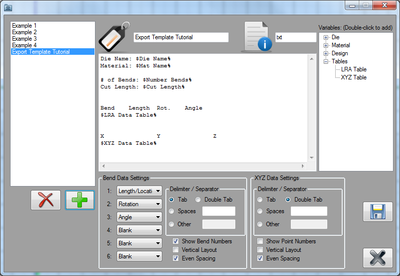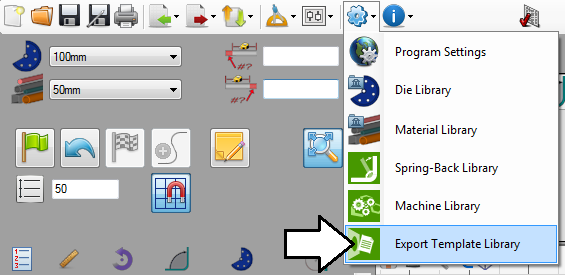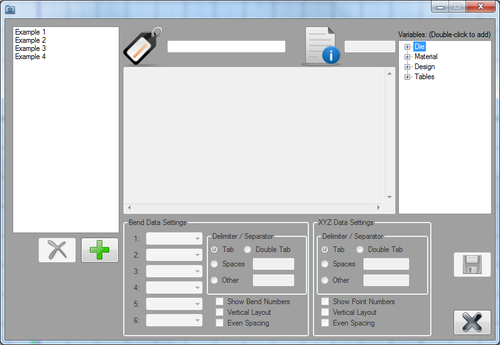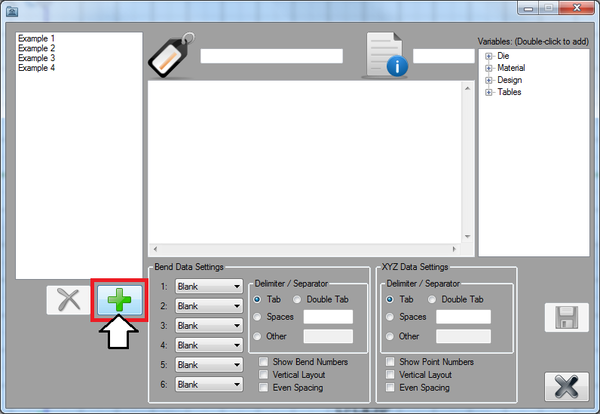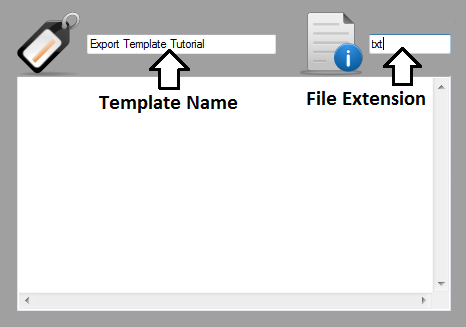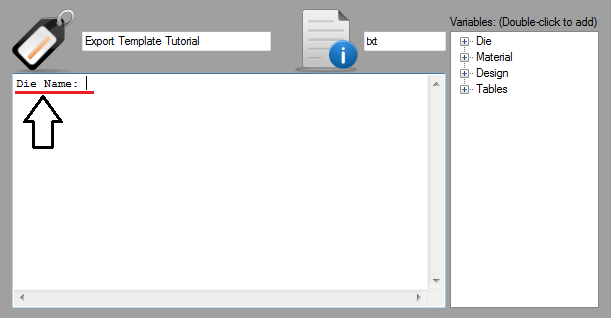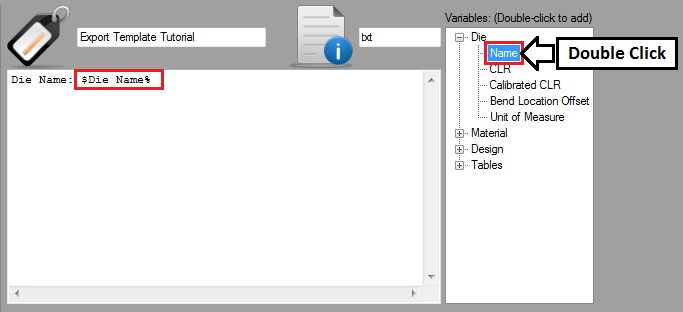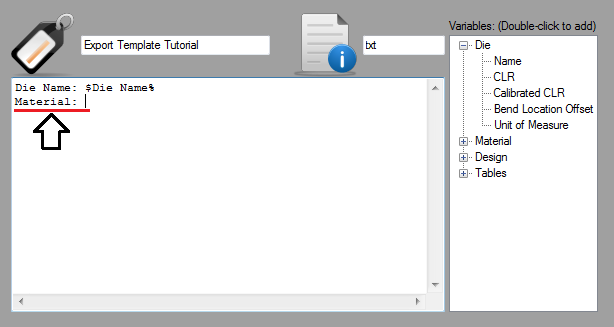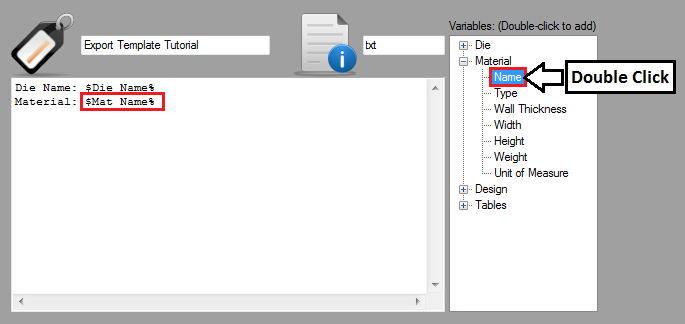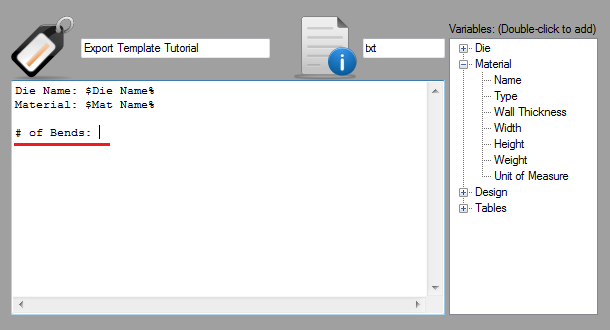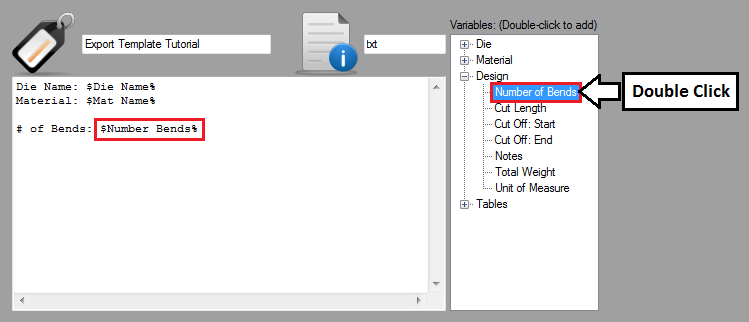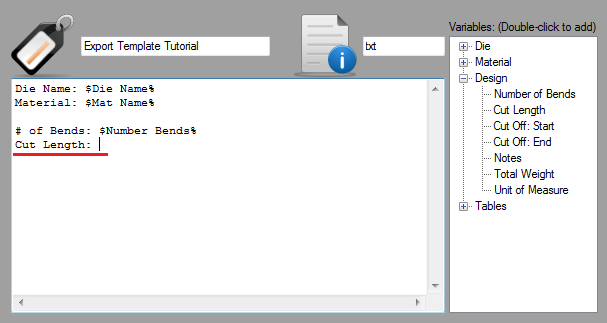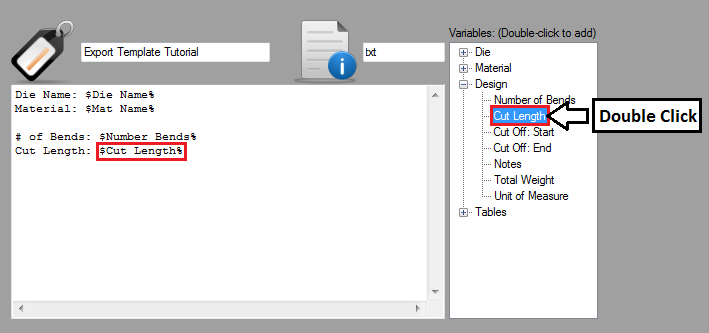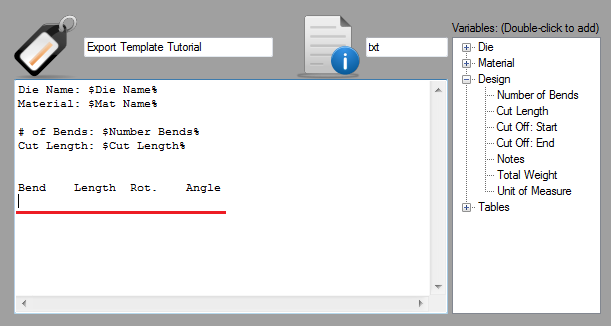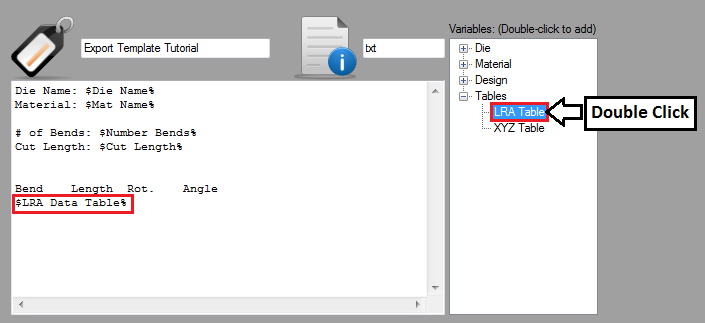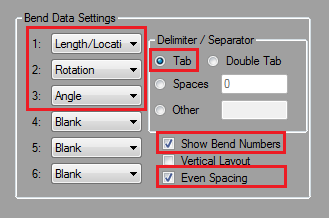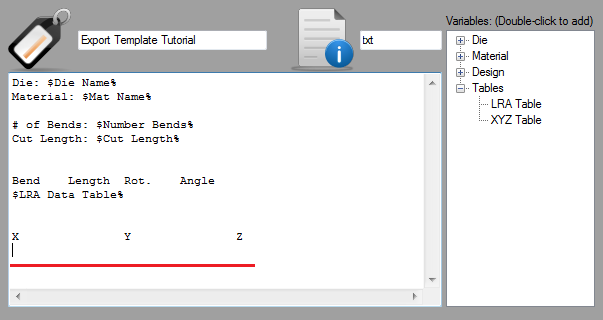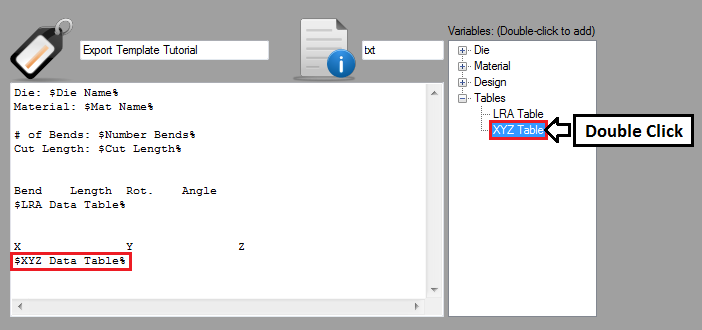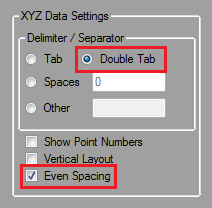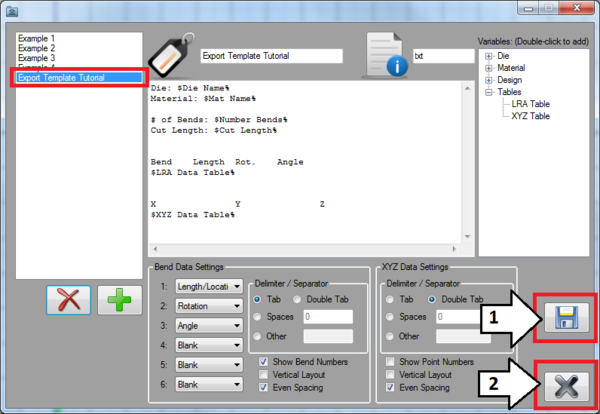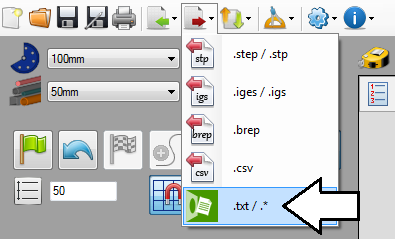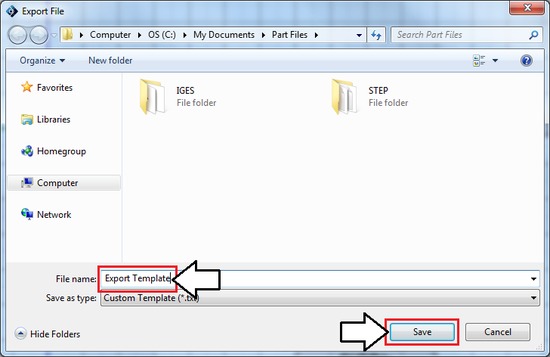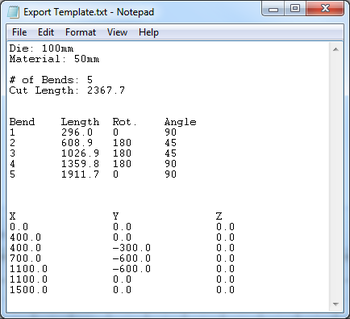Difference between revisions of "Export Template Tutorial"
(Created page with "==Introduction== right|400px This tutorial will step through the process of creating a custom export template using the Export Template plug-in. The...") |
|||
| (8 intermediate revisions by the same user not shown) | |||
| Line 24: | Line 24: | ||
==Tutorial== | ==Tutorial== | ||
| − | |||
| − | |||
| − | |||
| − | |||
| − | |||
| − | |||
==='''Step 1'''=== | ==='''Step 1'''=== | ||
| Line 41: | Line 35: | ||
==='''Step 2'''=== | ==='''Step 2'''=== | ||
| − | This will '''open the export template library'''. The list of templates is shown to the left. The area where the template will be designed is in the middle. On the far right, there will be a categorized list of variables. | + | This will '''open the export template library'''. The list of templates is shown to the left. The area where the template will be designed is in the middle. On the far right, there will be a categorized list of variables. The variables will act as placeholders for the actual part information that will be included in the file. |
[[File:extemp03.png|500px]] | [[File:extemp03.png|500px]] | ||
| Line 53: | Line 47: | ||
First, '''click the add button''' to start a new export template design. | First, '''click the add button''' to start a new export template design. | ||
| − | [[File:extemp04.png| | + | [[File:extemp04.png|600px]] |
| + | |||
| + | |||
| Line 60: | Line 56: | ||
==='''Step 4'''=== | ==='''Step 4'''=== | ||
| + | At the top, the name and the file extension for the template can be provided. | ||
| + | |||
| + | '''In the name field, enter "Export Template Tutorial"''' and '''in the file extension field, enter "txt"'''. | ||
| + | |||
| + | [[File:extemp05.png]] | ||
| + | |||
| + | |||
| + | |||
| + | |||
| + | |||
| + | |||
| + | ==='''Step 5'''=== | ||
| + | '''Now the template will be designed.''' | ||
| + | |||
| + | First, '''click in the text box''' to place the cursor. '''Type in "Die Name:" followed by one space'''. | ||
| + | |||
| + | [[File:extemp06.png]] | ||
| + | |||
| + | |||
| + | |||
| + | |||
| + | |||
| + | ==='''Step 6'''=== | ||
| + | Next, the '''first variable will be placed'''. | ||
| + | |||
| + | Variables are added to template designs from the list on the right. The variables are split into 4 categories: Die, Material, Design, and Tables. Each category can be expanded by clicking the small plus icons. | ||
| + | |||
| + | '''Expand the Die section''' and '''double click the Name variable to add it to the design'''. The variable ($Die Name%) should be placed after the text that was added in the previous step. | ||
| + | |||
| + | [[File:extemp07.png]] | ||
| + | |||
| + | |||
| + | |||
| + | |||
| + | |||
| + | |||
| + | ==='''Step 7'''=== | ||
| + | Next, '''click at the end of the first line of text''' to place the cursor and '''hit the enter key on the keyboard''' to start a new line. '''Type in "Material:" followed by one space'''. | ||
| + | |||
| + | [[File:extemp08.png]] | ||
| + | |||
| + | |||
| + | |||
| + | Now the material name variable will be placed. '''Expand the Material section in the variables list''' by clicking the plus icon next to it. '''Double click on the Name variable''' as shown below. The variable ($Mat Name%) should be placed right after "Material:". | ||
| + | |||
| + | [[File:extemp09.png]] | ||
| + | |||
| + | |||
| + | |||
| + | |||
| + | |||
| + | |||
| + | ==='''Step 8'''=== | ||
| + | Next, '''click at the end of the last line of text''' to place the cursor. '''Hit the enter key twice''' to start a new line a couple rows down from the previous line of text. | ||
| + | |||
| + | '''Type in "# of Bends:" followed by one space''' as shown below. | ||
| + | |||
| + | [[File:extemp10.png]] | ||
| + | |||
| + | |||
| + | Now the bend number variable will be placed. '''Expand the Design section in the variables list''' by clicking the plus icon next to it. '''Double click on the Number of Bends variable''' as shown below. The variable ($Number Bends%) will be placed right after "# of Bends:". | ||
| + | |||
| + | [[File:extemp11.png]] | ||
| + | |||
| + | |||
| + | |||
| + | |||
| + | |||
| + | |||
| + | |||
| + | ==='''Step 9'''=== | ||
| + | '''Click at the end of the last line of text''' and '''hit the enter key'''. Then '''type "Cut Length:" followed by one space'''. | ||
| + | |||
| + | [[File:extemp12.png]] | ||
| + | |||
| + | |||
| + | |||
| + | Now the bend number variable will be placed. '''Double click on the Cut Length variable''' as shown below. The variable ($Cut Length%) will be placed right after "Cut Length:". | ||
| + | |||
| + | [[File:extemp13.png]] | ||
| + | |||
| + | |||
| + | |||
| + | |||
| + | |||
| + | |||
| + | ==='''Step 10'''=== | ||
| + | '''Click at the end of the last line''' and hit the '''enter key three times'''. In this step, an LRA table will be added. First, the columns will be labeled. | ||
| + | |||
| + | '''Type in "Bend"''', hit the tab key, then '''type "Length"''', hit the tab key, '''type in "Rot."''', hit the tab key, and then '''type in "Angle."''' | ||
| + | |||
| + | After "Angle", '''hit the enter key.''' | ||
| + | |||
| + | [[File:extemp14.png]] | ||
| + | |||
| + | |||
| + | |||
| + | Now the LRA table variable will be added. In the variable list, '''expand the Tables section''' by clicking the plus icon next to it. '''Double Click on the LRA variable''' as shown below. The variable ($LRA Data Table%) will be placed below the text added previously. | ||
| + | |||
| + | [[File:extemp15.png]] | ||
| + | |||
| + | |||
| + | |||
| + | |||
| + | Now the '''LRA table settings''' will be adjusted. In the '''Bend Data Settings'''' section near the bottom of the window, the columns, delimiter, and format options are shown. | ||
| + | |||
| + | [[File:extemp16.png]] | ||
| + | |||
| + | *'''Each column can be customized''' using the drop down menus. In this tutorial, the table will only have 3 columns. Select '''Length/Location''' in the first menu, '''Rotation''' in the second menu, and '''Angle''' in the third menu. Leave the others set to '''Blank'''. | ||
| + | |||
| + | *The '''delimiter/separator''' determines what is placed between each column in the LRA table. '''Click the option next to Tab'''. | ||
| + | |||
| + | *Check the box next to '''Show Bend Numbers'''. This will add a column at the beginning of the chart listing each bend number. | ||
| + | |||
| + | *Check the box next to '''Even Spacing'''. This will ensure each column is aligned properly. | ||
| + | |||
| + | |||
| + | |||
| + | |||
| + | |||
| + | |||
| + | |||
| + | |||
| + | |||
| + | ==='''Step 11'''=== | ||
| + | Next, '''click at the end of the last line''' of text. '''Hit the enter key three times'''. | ||
| + | |||
| + | '''Type in "X"''', hit the tab key twice, '''type "Y"''', hit the tab key twice, then '''type "Z"'''. | ||
| + | |||
| + | After Z, '''hit the enter key'''. | ||
| + | |||
| + | [[File:extemp17.png]] | ||
| + | |||
| + | |||
| + | |||
| + | Now the XYZ table variable will be added. '''Double Click on the XYZ variable''' as shown below. The variable ($XYZ Data Table%) will be placed below the text added previously. | ||
| + | |||
| + | [[File:extemp18.png]] | ||
| + | |||
| + | |||
| + | |||
| + | |||
| + | Now the XYZ table settings will be adjusted. In the '''XYZ Data Settings''' section near the bottom of the window, the delimiter and format options are shown. | ||
| + | |||
| + | [[File:extemp19.png]] | ||
| + | |||
| + | *The '''delimiter/separator''' determines what is placed between each column in the XYZ table. '''Click the option next to Double Tab.''' | ||
| + | |||
| + | *Check the box next to '''Even Spacing'''. This will ensure proper column alignment. | ||
| + | |||
| + | |||
| + | |||
| + | |||
| + | |||
| + | |||
| + | |||
| + | ==='''Step 12'''=== | ||
| + | The export template is now complete. '''Click the save button''', then click the '''close button'''. The template (Export Template Tutorial) will be added to the template list on the right. | ||
| + | |||
| + | [[File:extemp20.png|600px]] | ||
| + | |||
| + | |||
| + | |||
| + | |||
| + | |||
| + | ==='''Step 13'''=== | ||
| + | '''''Note:''''' '''''The following step is optional'''''. It will go through the process of actually exporting the file using the template created in this tutorial.'' | ||
| + | |||
| + | |||
| + | First, have a '''complete part design open'''. (The one used here is the part created in the [[Linear 2D Designer Tutorial]].) | ||
| + | |||
| + | |||
| + | Next, go up to the main menu bar and '''click the export menu. Select the .txt/.* option'''. | ||
| + | |||
| + | [[File:extemp21.png]] | ||
| + | |||
| + | |||
| + | |||
| + | In the menu that appears, choose the Export Template Tutorial from the drop down menu. | ||
| + | |||
| + | [[File:extemp22.png]] | ||
| + | |||
| + | |||
| + | |||
| + | |||
| + | '''Give the file a name''', "Export Template", and '''click the save button'''. | ||
| + | |||
| + | [[File:extemp23.png|550px]] | ||
| + | |||
| + | |||
| + | |||
| + | |||
| + | Now, '''locate the txt file and open it to see its contents.''' | ||
| + | |||
| + | [[File:extemp24.png|350px]] | ||
| + | |||
| + | |||
| + | |||
| + | |||
| + | |||
| + | |||
| + | ==='''Step 14'''=== | ||
| + | '''The tutorial is complete!''' | ||
| + | |||
| + | See the '''[[Export Template]]''' plug-in page for more information. | ||
Latest revision as of 08:45, 24 July 2013
Contents
Introduction
This tutorial will step through the process of creating a custom export template using the Export Template plug-in.
The export template plug-in allows parts to be exported to a file with custom formatting that can include die, material, and part design information.
Tutorial
Step 1
Go up to the top of the window and click on the Settings menu on the main menu bar. Select the Export Template option from the drop down menu as shown below.
Step 2
This will open the export template library. The list of templates is shown to the left. The area where the template will be designed is in the middle. On the far right, there will be a categorized list of variables. The variables will act as placeholders for the actual part information that will be included in the file.
Step 3
First, click the add button to start a new export template design.
Step 4
At the top, the name and the file extension for the template can be provided.
In the name field, enter "Export Template Tutorial" and in the file extension field, enter "txt".
Step 5
Now the template will be designed.
First, click in the text box to place the cursor. Type in "Die Name:" followed by one space.
Step 6
Next, the first variable will be placed.
Variables are added to template designs from the list on the right. The variables are split into 4 categories: Die, Material, Design, and Tables. Each category can be expanded by clicking the small plus icons.
Expand the Die section and double click the Name variable to add it to the design. The variable ($Die Name%) should be placed after the text that was added in the previous step.
Step 7
Next, click at the end of the first line of text to place the cursor and hit the enter key on the keyboard to start a new line. Type in "Material:" followed by one space.
Now the material name variable will be placed. Expand the Material section in the variables list by clicking the plus icon next to it. Double click on the Name variable as shown below. The variable ($Mat Name%) should be placed right after "Material:".
Step 8
Next, click at the end of the last line of text to place the cursor. Hit the enter key twice to start a new line a couple rows down from the previous line of text.
Type in "# of Bends:" followed by one space as shown below.
Now the bend number variable will be placed. Expand the Design section in the variables list by clicking the plus icon next to it. Double click on the Number of Bends variable as shown below. The variable ($Number Bends%) will be placed right after "# of Bends:".
Step 9
Click at the end of the last line of text and hit the enter key. Then type "Cut Length:" followed by one space.
Now the bend number variable will be placed. Double click on the Cut Length variable as shown below. The variable ($Cut Length%) will be placed right after "Cut Length:".
Step 10
Click at the end of the last line and hit the enter key three times. In this step, an LRA table will be added. First, the columns will be labeled.
Type in "Bend", hit the tab key, then type "Length", hit the tab key, type in "Rot.", hit the tab key, and then type in "Angle."
After "Angle", hit the enter key.
Now the LRA table variable will be added. In the variable list, expand the Tables section by clicking the plus icon next to it. Double Click on the LRA variable as shown below. The variable ($LRA Data Table%) will be placed below the text added previously.
Now the LRA table settings will be adjusted. In the Bend Data Settings' section near the bottom of the window, the columns, delimiter, and format options are shown.
- Each column can be customized using the drop down menus. In this tutorial, the table will only have 3 columns. Select Length/Location in the first menu, Rotation in the second menu, and Angle in the third menu. Leave the others set to Blank.
- The delimiter/separator determines what is placed between each column in the LRA table. Click the option next to Tab.
- Check the box next to Show Bend Numbers. This will add a column at the beginning of the chart listing each bend number.
- Check the box next to Even Spacing. This will ensure each column is aligned properly.
Step 11
Next, click at the end of the last line of text. Hit the enter key three times.
Type in "X", hit the tab key twice, type "Y", hit the tab key twice, then type "Z".
After Z, hit the enter key.
Now the XYZ table variable will be added. Double Click on the XYZ variable as shown below. The variable ($XYZ Data Table%) will be placed below the text added previously.
Now the XYZ table settings will be adjusted. In the XYZ Data Settings section near the bottom of the window, the delimiter and format options are shown.
- The delimiter/separator determines what is placed between each column in the XYZ table. Click the option next to Double Tab.
- Check the box next to Even Spacing. This will ensure proper column alignment.
Step 12
The export template is now complete. Click the save button, then click the close button. The template (Export Template Tutorial) will be added to the template list on the right.
Step 13
Note: The following step is optional. It will go through the process of actually exporting the file using the template created in this tutorial.
First, have a complete part design open. (The one used here is the part created in the Linear 2D Designer Tutorial.)
Next, go up to the main menu bar and click the export menu. Select the .txt/.* option.
In the menu that appears, choose the Export Template Tutorial from the drop down menu.
Give the file a name, "Export Template", and click the save button.
Now, locate the txt file and open it to see its contents.
Step 14
The tutorial is complete!
See the Export Template plug-in page for more information.
